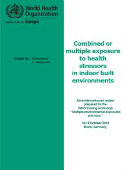Combined or multiple exposure to health stressors in indoor built environments

Download
Millions of citizens within the WHO European Region spend approximately 90% of their time indoors: in their homes (2/3 of this time), workplaces, schools, and public spaces. Despite undeniable improvements in the quality of indoor environments in the last twenty years, a range of health risks still exists, such as indoor air pollution, injury risks, noise, humidity, mould growth, inadequate indoor temperature, lack of hygiene and sanitation equipment, and crowding. Many of these risks are either directly or indirectly related to the quality of the building. Furthermore, problems with building quality disproportionally affect vulnerable population groups in terms of socioeconomic status or class age.
Despite the scientific progress in understanding the connection between indoor environments and health, evidence is often restricted to categorical studies targeting specific health risks and/or outcomes; much less evidence is available regarding the combined or multiple exposure to risk factors.
This report aims to explore and shed light on the links between different exposure stressors and modifiers people confront in residential dwellings, day care centers, schools and kindergartens. It summarizes a systematic review of literature and project reports presenting evidence on multiple or combined risk exposure in indoor environments, covering the range of
health risks encountered.



